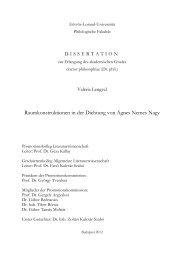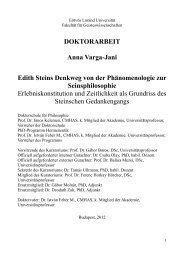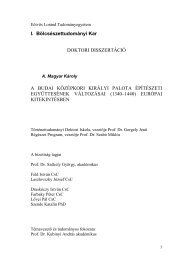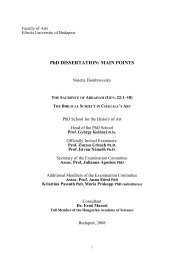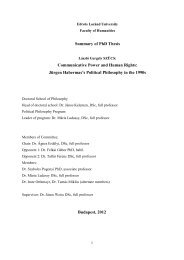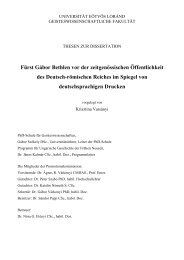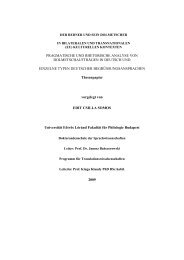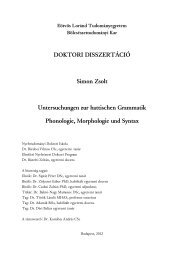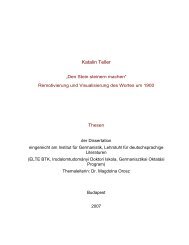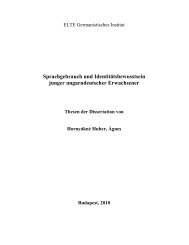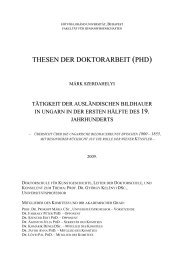Zsuzsanna Kutasi - ELTE BTK disszertációk
Zsuzsanna Kutasi - ELTE BTK disszertációk
Zsuzsanna Kutasi - ELTE BTK disszertációk
You also want an ePaper? Increase the reach of your titles
YUMPU automatically turns print PDFs into web optimized ePapers that Google loves.
When the name of a smaller part within a bigger body part has been translated from Arabic<br />
into one of the European languages, it was collapsed into the bigger one’s name. Thus the<br />
smaller part is named with the bigger’s name: the croup, the chest, the neck or the hoof and so<br />
on. But we can find similar simplifications in the Arabic authors too, for example, in the case<br />
of markal and ma‘add. While Abū ‘Ubayda has distinguished them and said that the markal<br />
was the place on the horse’s sides, at which the rider urges it (yurakkiluhu) for a gallop,<br />
behind the elbows, it seems that the ma‘add does not really have the same meaning: two sides<br />
of a horse at the place of a rider’s feet, hard, stiff muscular tissue on its two sides, behind the<br />
shoulders. 25 Namely this is a description of a body part anatomically, and not merely the<br />
identifications of a place on the horse’s body. Thus the two expressions do not mean the<br />
same, yet some authors do not distinguish them because of their identical location. For<br />
example al-’AÒma‘ī (d. 213/828) in his Kitāb al-khayl, who seems a more practical scientist<br />
than Abū ‘Ubayda, held both of them to be the same thing, but then he is not so meticulous in<br />
the description of the horse.<br />
As to the ma‘add, al-Nuwayrī (d.733/1333) says that it is at the place of the girth on the<br />
horse’s sides. 26<br />
Ibn Sīda (d.488/1066) has collected a lot of explanations from different authors about the<br />
body parts of the horse. 27 For example, the Îawšab means for Abū ‘Ubayd the interior of the<br />
hoof (Îašw al-Îāfir), just like the ğubba (ankle). Abū ‘Ubayda states that the Îawšabān means<br />
the two bones of the pastern (rusġ). Ibn Sikkīt holds that the ğubba is the same as the Îāfir.<br />
The ğubba means in the al-mu‘ağam al-wasīÔ the joint between the sāq (tibia) and the fahid<br />
(thigh), namely the stifle. Its means also the Îiğāğ (palpebra) in the eyes. If we look into the<br />
muÎīÔ al-muÎīÔ, the ğubba means, beside the above, the connecting part between the Îāfir<br />
and the waÛīf (cannon). Since this description does not mention the pastern between the hoof<br />
and the cannon, we can conclude it that the Îāfir means both the hoof and the pastern together.<br />
The Îāfir as nail sometimes replaced with the word sunbuk (the wall), but in the meaning of<br />
“hoof”. (See above, when the smaller part was named by the bigger’s name.)<br />
Al-MaÒ‘ūdī quotes a short story 28 from the time of the caliph ‘Umar (634-644), who held<br />
examination for the horse to determine their nobility. They put a vessel full of water on the<br />
ground and led the horses one after an other to drink from it. That horse which drank from the<br />
25 Abū ‘Ubayda, Kitāb al-hayl. Cairo, 1986. pp. 204.<br />
26 Al-Nuwayrī, Nihāyat al-’arab. 1933 Cairo, vols. 25/10. pp. 2.<br />
27 Ibn Sīda, al-muhaÒÒaÒ. Beirut n.d. vols 6/2. pp. 138.<br />
28 Murūğ ad-dahab, Beirut, 1989. vols. 2/2. pp. 696.<br />
10



